

C RESSET. THE
The Promise of Freedom
4
DONOR SOCIETIES NEWSLETTER
A Revolutionary Year Awaits!
No place like it in 1776. No place like it now.
6
The Power of Our Community
Since launching the public phase of The Power of Place — The Centennial Campaign for Colonial Williamsburg two years ago, all of us here at the Foundation have been moved by the remarkable response of our dedicated donors. We set forth a bold vision for the Campaign — to lead the nation in a reflection on our founding principles as we mark the 250th anniversary of the Declaration of Independence and our own centennial — and your support has risen to the challenge, moving forward the preservation, education and civic engagement initiatives central to this effort. As we remain focused on finishing out another strong fundraising year, your generosity and passion continue to help us achieve great things.
We have made significant progress on many of our historic preservation projects, transforming the Historic Area and uncovering new information about the past. Donor gifts drove the five years of research, scientific analysis and careful restoration of the Williamsburg Bray School, which fully opened to visitors on Juneteenth 2025. Thanks to your investment, this meaningful project was fully funded. Now

News of Your Impact on The Colonial Williamsburg Foundation
Williamsburg Bray School Now Open
The culmination of five years of transformative research and preservation work.
7
completely restored, the school allows us to share the stories of the enslaved and free Black children who attended the school while laboring in 18thcentury Williamsburg’s shops and households.

Adjacent to the Bray School on Nassau Street, work is also underway on our reconstruction of the African Baptist Meeting House and Burial Ground, the original permanent location of the First Baptist Church. The archaeological investigation and planning for this site, including the discovery of 62 burials, have been carried out in collaboration with the present-day church and descendant community. In November 2024, we held a private sunrise ceremony for the community to rededicate the Burial Ground and honor their ancestors who were laid to rest there, marked by specially designed grave markers. We broke ground on the reconstruction of the Meeting
Continued on page 3
We are pleased to present the fall 2025 issue of The Cresset
A sensory experience that helps to define Colonial Williamsburg, cressets line Duke of Gloucester Street. They are used for a small fire, burning as a light or beacon. This newsletter is intended to be just that a beacon to highlight the stories, places, people and projects that demonstrate...

The Revolution Is Here.
For membership information and assistance, please contact The Colonial Williamsburg Foundation at donorrelations@cwf.org.
A new street theater program explores reactions to Dunmore’s Proclamation.
The African Baptist Meeting House ceremonial groundbreaking.
The Williamsburg Bray School.

Working Together to Bring History to Life
Dear Friends,
Every day I am reminded what makes this powerful place so special. While the history of what happened here is meaningful, so are those who make up this present-day community of people excited about sharing that history with the nation.
First thing in the morning, our historic interpreters gather to prepare for the day, checking schedules, receiving updates from leadership and spending time researching before opening sites to guests. Know that we do this with you in mind. It is a privilege and an honor to work alongside such incredibly talented colleagues, and it is also rewarding to know that you care deeply for Colonial Williamsburg and our mission.
On page 8, you’ll meet the Fought family of Ohio. They first visited Williamsburg in 2009 when their oldest child was just 15 months old and were inspired to become more involved with the Foundation. Over the years and with each new addition, they continue to come back while also sharing our mission within their community. The entire family — Joe, Elizabeth, William, Daniel, Katherine and Margaret — decided to increase their giving to join the Raleigh Tavern Society and experience all that comes with their membership together. As you’ll hear from Joe, it’s the passion and enthusiasm of everyone they meet here that fuel their love for this remarkable institution.
Elizabeth also shares something I have heard from so many of you: Williamsburg feels like home.
THE CRESSET
This newsletter is published by The Colonial Williamsburg Foundation exclusively for members of the Colonial Williamsburg Burgesses, Colonial Williamsburg Associates, Raleigh Tavern Society and The W.A.R. Goodwin Society.
Cliff Fleet, President & CEO
The Colin G. and Nancy N. Campbell Distinguished Presidential Chair
Sani Silvennoinen, Chief Development Officer
WRITERS
Elizabeth Henderson, Emily MacIntosh and Rachel West
EDITOR
Rachel West
CONTRIBUTING
EDITORS
Betsy Edwards and Laura Potts
ART DIRECTOR Bob McCracken
PROOFREADER
Elizabeth Narney
PHOTOGRAPHERS
Brendan Sostak and Brian Newson
For membership information and assistance, please contact The Colonial Williamsburg Foundation, P.O. Box 1776, Williamsburg, VA 23187-1776 or email donorrelations@cwf.org.
You may also call 1-888-293-1776.
It’s the people that truly make Colonial Williamsburg so special, and that includes you. You inspire us every single day to advance history education in this country and engage the next generation. And as made clear by donors like the Foughts, the next generation is already stepping up.
Throughout this issue you will learn more about our plans to commemorate the U.S. Semiquincentennial and Colonial Williamsburg’s centennial in 2026; receive an update on our Power of Place Campaign; and enjoy a photo spread of our recently completed restoration of the Williamsburg Bray School — funded entirely by donors. Our 2024 Donor Registry can be found on the back page.
I hope that we inspire you to continue investing in our mission and help us succeed in our preservation, education and civic engagement goals. Thank you for all you do.
Warmly,

Sani Silvennoinen Chief Development Officer
Continued from page 1 The Power of Our Community House this summer (read more on page 9), and we are pleased to share that your contributions mean this project is fully funded as well.
Ongoing preservation projects include the Magazine, Custis Square and the Peter Scott House and Shop. The Magazine now better represents how the building would have appeared in the mid-18th century, with its lowered perimeter wall and restored lunette window on the front elevation. These changes were completed in time for our commemoration of the 250th anniversary of the Gunpowder Incident this April, featuring our newest Nation Builder, Nat Lasley, as Col. Patrick Henry. Work continues on the structure’s exterior, supported by your philanthropy and grant funding through the Mary Morton Parsons Foundation and the Virginia 250 Preservation Fund.

Work on our latest archaeology project began in March, with excavations along Duke of Gloucester Street at the Peter Scott House and Shop site. Scott was a noted cabinetmaker who lived in Williamsburg from 1722 until his death in 1775, and he rented his house and shop — first from John Custis IV, then from his son Daniel Parke Custis and finally from George Washington, as his wife, Martha, was Daniel’s widow. Our investigation of the site has already revealed the circa 1714 foundation of the main building and evidence of associated outbuildings, helping us to better understand the site’s usage before the structures burned down in 1776. The new information we learn from the archaeology will guide our architectural reconstruction.

The archaeologists completed their five-year, giftfunded excavation at Custis Square at the end of 2024. After investigating almost an entire acre of the site, we now know the overall dimensions of John Custis IV’s ornamental garden and elements of its geometric design, including details like the locations of pathways and evidence of espaliered fruit trees. This information has informed our plans for the garden’s reconstruction, which we hope to begin in the fall of 2026.
After we broke ground on the Colin G. and Nancy N. Campbell Archaeology Center in 2023, our archaeology team discovered the remnants of a late 17th- to early 18th-century dwelling and brick well, preserved only a couple of feet below the ground surface. The thousands of artifacts they recovered will be displayed in the donorfunded Campbell Archaeology Center, and a specially designed glass floor panel will highlight part of the historic foundation. As construction on this state-of-the-art facility has progressed, it has been wonderful to see your support bring this project closer to completion.
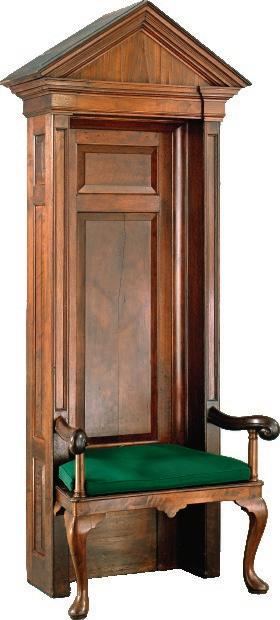
of Burgesses. It can now be seen in the reconstructed Capitol building.

In 2024, we celebrated 35 years of the Bob and Marion Wilson Teacher Institute of Colonial Williamsburg and finished renovations on the former Abby Aldrich Rockefeller Folk Art Museum, the Teacher Institute’s new home. The donor-funded renovation features dedicated classroom spaces for in-person workshops and improved capabilities for online programming. Continued on page 11
The Campbell Archaeology Center’s custom-designed glass floor, showcasing the historic foundation below.
The Magazine after spring 2025 renovations.
Nation Builder Nat Lasley portrayed Col. Patrick Henry during special evening performances of 1775 Gunpowder Plot to commemorate the Gunpowder Incident.
Cabinetmaker Peter Scott made the legs, arms, seat and arm supports of the ca. 1735 “Speaker’s chair,” a ceremonial chair used by the Speaker of the House
Dunmore’s Proclamation
Commemorating Anniversary Events,
Thanks to Donor Support

Theatrical Interpreter Serena Williams and Supervisor of Historical Performing Arts & Interpretation Willie Wright share a scene in The Promise of Freedom that explores the danger faced by enslaved African Americans following Dunmore’s Proclamation.
Less than two months after the events of the Gunpowder Incident, tensions remained high in Williamsburg and throughout the colony between Virginia’s royal governor, Lord Dunmore, and the prominent citizens who would become leading revolutionaries.
On June 8, 1775, Dunmore and his family abandoned the Governor’s Palace to take refuge aboard the warship HMS Fowey. Attempting to maintain control from the Fowey, he issued a proclamation on November 7 establishing martial law and offering freedom to any enslaved people or indentured servants in the service of patriots if they would fight for the British army.
Marking the 250th anniversaries of key events in 2024 and 2025 has allowed us to contextualize the history of the years leading up to 1776 and

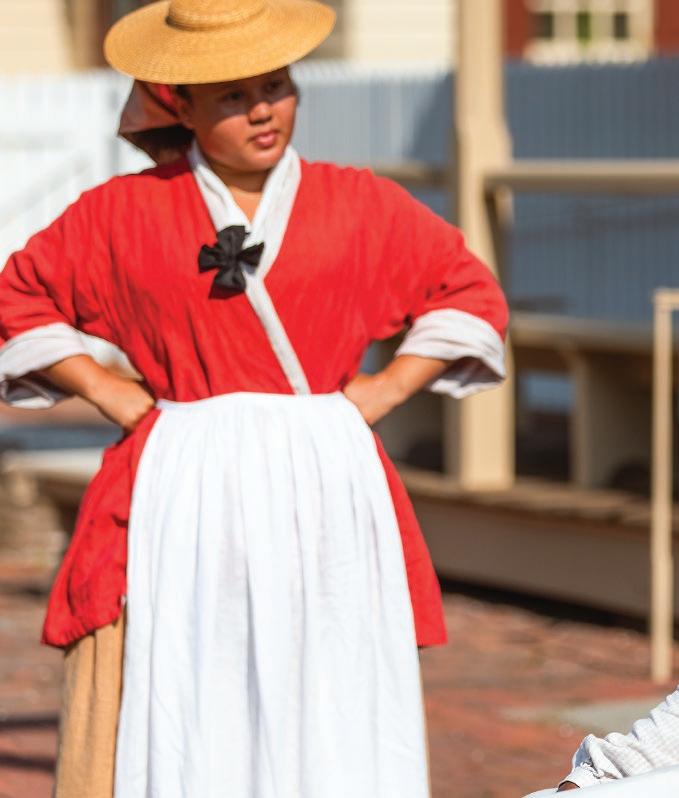
the Declaration of Independence, showing how we as a nation got there and where we are going today. Early in our planning for 2026 commemorations, Dunmore’s Proclamation was identified as an important moment for the residents of Williamsburg, provoking fear, hope and unrest among different segments of the community. The proclamation inspired many enslaved African Americans to risk capture and seek their freedom, but it also drove many wealthy white colonists to declare against King George III, angered by the imposition of martial law and what they believed to be a threat to property rights.
To set the stage for exploring this complicated history, our curatorial team reset the Governor’s Palace from May to September 2025 to interpret the chaotic weeks of late April to June 1775 when Dunmore and his family fled the city. The curators moved a writing desk to the center of the parlor, staged as if in use and covered in facsimiles of real letters the governor wrote during this time, expressing his concern for his family’s safety and the potential overthrow of government in Virginia. An installation in the dining room included pieces of silver and
In the Governor’s Palace dining room, pieces of silver and other valuables laid out on the table capture Dunmore’s hurried preparations to leave Williamsburg.

“November
1775.
A proclamation declaring martial law has been placed in Virginia. Join the community as they confront the choices of an old promise fulfilled.”
a longarm overflowing a table and ready to be loaded into a nearby case, based upon the fact that the governor’s later claim of property losses did not list any silver. On the second floor, various garments were laid out in the bedrooms, either to be packed or left behind.
Nation Builder Stephen Seals, Actor Interpreter Hope Wright and Supervisor of Historical Performing Arts & Interpretation Emily Doherty have continued this historical narrative in a new interpretive program that they wrote together, The Promise of Freedom. Set in mid-November 1775, shortly after the publication of Dunmore’s Proclamation, the street theater piece examines the effects of the decree’s words on the people of Williamsburg and the choices of each character.
“Who is the protagonist? Who is the antagonist? Most people can’t answer that because we did not write a hero or villain,” said Seals.
“We wanted every decision for the characters to be hard,” added Doherty.
The Promise of Freedom debuted in September and is scheduled to run through the fall season,
performing daily on Duke of Gloucester Street in front of Charlton’s Coffeehouse. A rotating cast allows for the daily performances and offers repeat guests a new experience. Each performance features four characters: Elizabeth Randolph, mourning the recent loss of her husband, Peyton Randolph; Betty, an enslaved woman in Elizabeth Randolph’s household who wants to keep her family together and safe; Troy or Amy, enslaved servants facing an uncertain future as the estate of their enslaver, John Randolph, is being auctioned off after he fled for England; and David Allen, a convict servant who wants vindication. The program gives each character space to think about what Dunmore’s Proclamation could mean for them and invites the audience to join them on this journey.
“We want people leaving with questions, so they’ll want to learn more and ask, ‘What should I go see next,’” Wright shared.
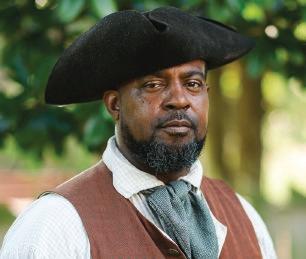

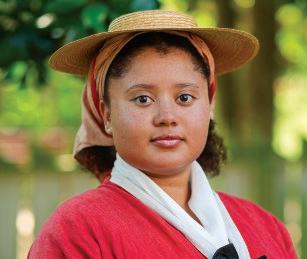
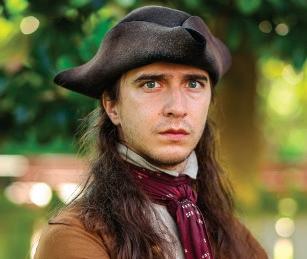
Developing this program involved roundtable discussions, research gathering, consultations with Colonial Williamsburg’s historians and the necessary time for script writing and revisions, as well as costumes, props and rehearsals. Donor support of our Museum Theater program makes all this work possible, ensuring that new and engaging first-person performances can continue to connect audiences with the people of 18th-century Williamsburg.
“We are bearing the fruit of past donor support to be able to tell these stories,” said Wright. “Their generosity pays dividends. We have people who return [to the Historic Area] who say they saw us in a program 20 years ago, and it inspired them to study history.” CW
For more information on giving to Museum Theater, email campaign@cwf.org.
In The Promise of Freedom, each character’s choices reflect their different motivations and social positions. From top to bottom, Willie Wright portrays Troy; Megan Sirak portrays Elizabeth Randolph; Serena Williams portrays Betty; and Austin Munden portrays David Allen.
A Revolutionary Year Awaits
No place like it in 1776. No place like it now.


The revolutionary spirit of the 18th century lives on in Williamsburg through bold ideas, groundbreaking preservation, hands-on education and dynamic civic engagement. As we celebrate the nation’s 250th anniversary and Colonial Williamsburg’s 100th in 2026, we welcome you to join us in honoring the past, engaging the present and inspiring the future.


closely with historians and digital staff to create experiences that will present Williamsburg’s stories in entirely new and exciting ways while reinforcing our central role in the early American story.
As the world’s largest U.S. history museum, Colonial Williamsburg is leading the way in planning for 2026. Over the past several years, we have convened the nation’s museums, scholars, educators and civic leaders to plan a celebration and commemoration that will inspire millions around the world. Collaborations with William & Mary, the Omohundro Institute of Early American History & Culture, VA250 and others have created impactful events that honor the people and events of the past that have shaped our present.
As 2026 draws nearer, our plans to commemorate America’s 250th anniversary are capturing the nation’s attention. We will honor the historic events of 1776 with a full year of celebrations, commemorations, grand openings and more.
To bring these moments to life, an artistic team comprising Nation Builders Katharine Pittman, Kurt Smith, Robert Weathers, Stephen Seals and others is writing and designing new programs for both the U.S. Semiquincentennial and the Foundation’s centennial. This team is working
“We will use dynamic performances and immersive interpretive experiences to guide our guests on a journey across the Historic Area, tracing the dramatic years of 1774 – 1776,” Associate Vice President for Performing Arts & Signature Events Robert Currie said. “Guests will travel from the crumbling royal authority to the bold vote for Virginia’s independence that pushed Jefferson’s draft of the Declaration of Independence.”
Other highlights of the coming year include the opening of the Colin G. and Nancy N. Campbell Archaeology Center; commemorations of the Fifth Virginia Convention and the Virginia Declaration of Rights; the dedication of the African Baptist Meeting House and Burial Ground; and, of course, a July 4 grand celebration throughout the Historic Area.
This is a remarkable moment for the Foundation and our nation, and we are deeply thankful to the donors and friends whose support has brought us to this point. Your generosity makes our 250th anniversary events, 2026 commemorations and daily programs possible. We invite you to return to the Historic Area often and be part of this exciting chapter in our shared journey.
Williamsburg Bray School Now Open to the Public
The public opening of the Williamsburg Bray School, held on Juneteenth, was the culmination of five years of transformative research and preservation work. Our modern and historic trades, preservation, curatorial and research teams worked together closely with the William & Mary Bray School Lab to carefully restore and furnish the building.
Furniture, books and other items inside the building were reproduced based on 18thcentury examples by tradespeople, including bookbinders, cabinetmakers and printers.
Today, guests can visit the interior of the school, where enslaved and free children studied under the religious tutelage of schoolmistress Ann Wager from 1760-1774. The complicated stories of the Bray School have deepened our understanding of the intersection between race, religion and education in early America, and we will continue to learn from them. We are grateful to the many donors and organizations who have invested in this initiative.

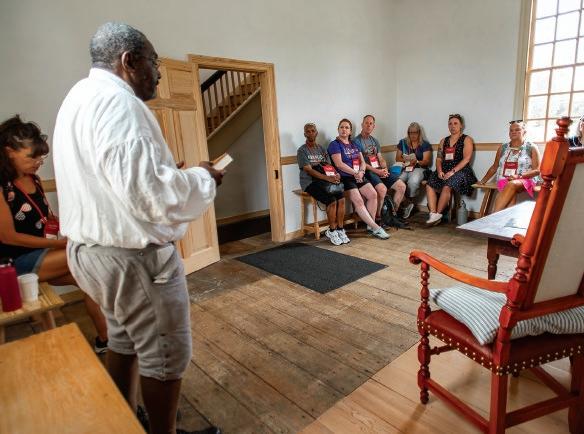
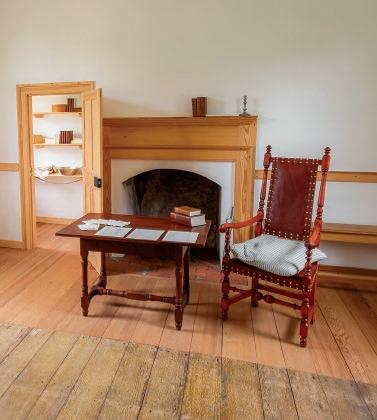

(left, top to bottom)) A ribbon cutting ceremony including representatives of Colonial Williamsburg and William & Mary and featuring performances by the Descendant Children’s Choir officially opened the school to the public; Educators participating in the Teacher Institute visit the Bray School; Visitors interacted with curators and architectural historians to learn more about the Bray School on Juneteenth.
(right, top to bottom) An interior first-floor room where Ann Wager likely taught her students; Papers and books staged on a desk in the lower west room show some of the materials students may have used at the school; The back of the Williamsburg Bray School as it nears completion.


Donor Spotlight – The Fought Family
Leaving a Legacy: Inspiring the Next Generation
Joe and Elizabeth Fought are passionate about sharing their love of Colonial Williamsburg with the next generation, starting with their own children. They first visited Williamsburg with family and friends in the spring of 2009. Joe had recently returned from a deployment to the Middle East and their oldest son, William, was 15 months old. Williamsburg immediately felt like home and it became clear to them that they wanted their involvement with the Foundation to be more than just as visitors. They decided then to make their first gift to the Foundation.
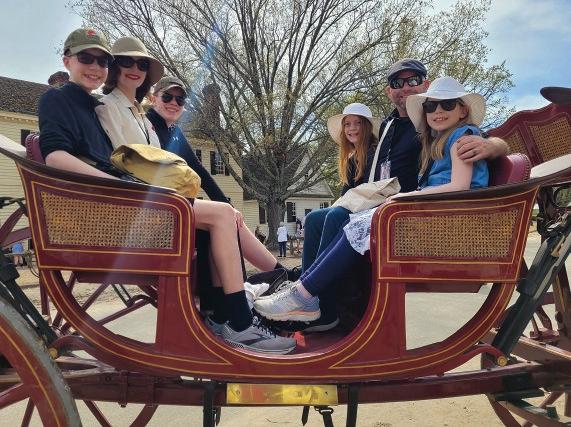
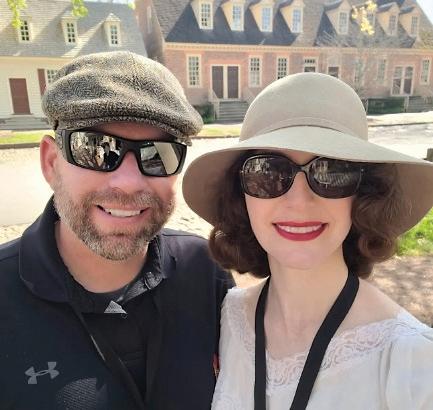
“This is such a unique historical site, and you learn so much that it keeps you coming back. It really feels like home for us.”
Now, as members of the Raleigh Tavern Society and with three more children — Daniel, Katherine and Margaret — they visit the Historic Area as often as they can. They have made it their mission to introduce other young families to this powerful place by championing Colonial Williamsburg within their broader community and school district and bringing back information about student visits and teacher participation in the Bob and Marion Wilson Teacher Institute of Colonial Williamsburg.
For the Foughts, Williamsburg is a place where their children can experience history firsthand, touching artifacts and moving through spaces where the stories of our past feel more accessible. “It feels so open and welcoming for people of all ages,” said Elizabeth. “It’s very special to be there with family and share in that together. All our kids have grown up there.”
The family’s connection to Colonial Williamsburg goes beyond the yearly spring break trips. They have felt deeply connected to the military history and programs they have experienced during their visits. “Colonial Williamsburg tells the story of history in such a fantastic way,” Elizabeth said. “As a military family, to be present there and walk the streets where independence began and to think about the continued sacrifice that is made to carry on that freedom, it is extremely meaningful.”
The prevalent sense of community and belonging they have found here has led them to increase their giving to become Raleigh Tavern Society members. After discussing it as a family, they decided together that membership would be a priority for them and that each family member would contribute what they could toward reaching that level of giving. Now, they get to take advantage of everything that comes with membership, including attending donor meetings each year.
For Joe, one of the best parts of attending the Raleigh Tavern Society meetings as a family is being able to see all that their investment supports. He said, “Being able to see the results of the investment we’re making and knowing that we have helped share history and the passion for history with the next generation is inspiring. Even the children are inspired by the enthusiasm and passion of everyone they meet in Williamsburg. And we love that we get to do it as a family.”
Donors like the Foughts show that it is never too early to live a life of dedication and service. The seeds for a brighter tomorrow can be planted at any age, and they hope others will join them in supporting our important work. “Let’s get more young people involved as donors and members,” Joe said. “Williamsburg is made for families!”
Top (L to R): Daniel, Elizabeth, William, Katherine, Joe and Margaret Fought taking a carriage ride through the Historic Area.
Bottom: Joe and Elizabeth Fought on a trip to Williamsburg.
Tucker House Happenings
The St. George Tucker House, our premier donor reception center, offers eligible donors a comfortable place to relax and enjoy light refreshments, engage with fellow donors and experience exclusive programs.
Exclusive Programming at the Tucker House
Make your reservations for our fall donor programs. The Donor Visit with a Nation Builder program is a wonderful way to engage with historic interpreters in upclose and personal conversations. Programs are offered on Tuesday and Thursday mornings

Artisan Programming
Artisan demonstrations have become an integral part of Tucker House programming. Quilting, lacemaking and painting are just a few of the 18thcentury art forms showcased by our resident artisans. Artisans demonstrate and engage in conversation with guests about the history and techniques from 10 a.m. – 11 a.m. Space is limited, so reserve your seats today by calling 877-293-8477.

of their specialty. They are available as scheduled in the afternoons from 12:30 p.m. – 4 p.m. in a come-and-go format which does not require a reservation.
Holidays at the Tucker House
This year, the Tucker House will open its doors to the public from 9 a.m. – 12 p.m. on December 6, 13 and 20, coinciding with the dates of Grand Illumination. This will be an opportunity to tour the house, hear from volunteers and learn more about this exciting membership benefit.
Breaking Ground on a Forgotten Piece of History
This summer, on the morning of Juneteenth, we held a ceremonial groundbreaking for the reconstruction of the African Baptist Meeting House. Joined by members of the First Baptist Church, daughter churches and the descendant families of Williamsburg, speakers and attendees reflected on the power and significance of the moment.
“Today is more than a groundbreaking,” Dana Tomlin, Colonial Williamsburg’s chief of staff, said. “This is a homecoming…In lifting up this space again, we’re not just reconstructing a building. We’re restoring a dignity to a community’s voice, honoring a legacy that has long deserved recognition.”
The reconstruction of the Meeting House is a project of national significance that will bring to light the important and overlooked history of the First Baptist Church, one of the earliest African American congregations in the United States,
which is still active today. Officially founded in 1776, the enslaved and free Black congregation came together in 1805 to build the first permanent home for their church on Nassau Street. The project to reconstruct the Meeting House will deepen our connection with the Williamsburg community and further our commitment to providing an accurate representation of the diverse people of 18th-century Williamsburg. Once rebuilt, the Meeting House will stand next to the restored Williamsburg Bray School, serving as a nexus for African American programming in the Historic Area.

Representatives from the First Baptist Church and descendant community came together to perform the ceremonial groundbreaking at the African Baptist Meeting House site on June 19, 2025.
We plan to open the reconstructed Meeting House to the public in October 2026, coinciding with the church’s 250th anniversary.
During this spring’s A Common Cause to All conference, Ken Burns stopped by the Historic Area to share an exclusive preview of his new film.
Colonial Williamsburg Helps Bring Ken Burns Documentary to Life
This fall, Ken Burns’ latest documentary, The American Revolution, will premiere on PBS. In March, nearly 4,000 people attended a special sneak preview of the documentary on the Palace Green, but starting November 16, the full six-part, 12-hour series will begin airing to a wider audience. The film tells the story of the American Revolution through the accounts of the real people who lived through it and examines its global impact. In production for almost 10 years, it features many scenes filmed here in the Historic Area.

“I have to say that central to our being able to tell the story of an event that took place before photographs and before newsreels was the need to go to places where the buildings are as

they were,” said Burns. “And there’s no greater resource than Colonial Williamsburg.”
Beyond the streets and buildings of the Historic Area providing background for the documentary, filming our historic interpreters and tradespeople as they go about their daily work — carding wool, working with livestock animals to plow a field, hammering iron in the blacksmith shop — was important to capture the sights and sounds of 18th-century life.
“There’s a sense that real Americans lived through it, and not just all the boldface names that we’re familiar with,” Burns added. “They’re there, and they have the biggest parts, but it’s really important to tell what it was like from Georgia to New Hampshire for ordinary people.”
For more information on the documentary and how to watch it when it premieres, visit pbs.org.
Your Voice is Shaping the Future
Our survey results — in your own words
We are deeply grateful to everyone who took part in our recent donor survey. We truly value your input as we continue the important work of preserving history and inspiring future generations. Over 95% of survey recipients strongly agree that Colonial Willliamsburg is important to the United States! Stay tuned for more updates on survey results.
To remain up to date on the impact of your gift, be sure to subscribe to our Development emails by visiting colonialwilliamsburg.org/subscribe.
“My husband and I renewed our vows on our 25th wedding anniversary under the big tree near the old courthouse — it was a magical moment.”
— Luanne S., Maryland (first gift 2000)
“For 28 years, I’ve witnessed CW offering consistently professional and relatable portrayals of historical figures with excellent tie-ins to today. Beautiful, flourishing gardens and exciting trades.”
— Jody E., South Carolina (first gift 2004)
Donation Expands Library’s Collection with
Difficult-To-Source Items
Three significant private collections of books, journals and catalogs relating to art and antiques and early American history were donated to the John D. Rockefeller, Jr. Library by James Murray, Jr. Two of these collections served for many years as important reference libraries to the Richmond-based art & antiques dealers Robert E. Crawford and Marshall Goodman. Mr. Crawford established Robert Crawford Fine Art and Antiques in 1972. Especially strong in works on American folk art and all areas of American and European decorative arts, over 1,000 titles are represented in his collection. The library of Mr. Goodman, a published scholar and prominent antiques dealer for over 50 years, includes hundreds of titles on African American art, southern decorative arts, firearms and more. Mr. Murray’s gift rounds out the collection with
Continued from page 3 The Power of Our Community
The Teacher Institute continues to have a national impact, serving more teachers each year and reaching countless students thanks to the support of our committed donors.

Innovative digital resources, grounded in the Foundation’s historical research, are also an important part of our education and civic engagement efforts. We have now launched two online games that we developed in collaboration with iCivics, Uncovering Loyalties with Colonial Williamsburg and Investigation Declaration, with
difficult-to-source reference material on art, antiques and Virginia history.
Library staff continue to review and document the almost 5,000 items included in the collections, with notable additions such as Early American Bottles & Flasks by Stephen Van Rensselaer; Bucket Town: Wooden Ware and Wooden Toys of Hingham, Massachusetts, 16351945 by Derin T. Bray; and Auguste Edouart’s Silhouettes of Eminent Americans 1839-1844 by Emma B. Oliver.



the latter winning a prestigious GEE! award in educational game design. Additionally, working in collaboration with leading museums, historic sites and civic education organizations across the country, we launched a closed beta version of history.org in December 2024. These digital initiatives are central to our goal to increase our educational reach and develop into the world’s largest virtual U.S. history museum.

Your support of the Power of Place Campaign empowers Colonial Williamsburg to meet these historic moments that our centennial and the nation’s 250th anniversary present. More work remains, including the planned reconstruction of the Randolph Stable, but the accomplishments which your generosity has already made possible are a lasting testament to the power of philanthropy. We are proud to be with you on this journey.
In Investigation Declaration, players visit multiple historic places and time periods to learn about the global impact of the Declaration of Independence.
The Bob and Marion Wilson Teacher Institute of Colonial Williamsburg.
The Donor Registry is Now Available
Our 2024 Donor Registry is now live on our website! In 2024, nearly 57,000 donors joined us to make a lasting impact and advance our mission, That the future may learn from the past. Your gifts made it possible for us to continue to share the stories of the people, places and events of 18th-century Williamsburg by supporting the talented people who bring this history to life and preserve the Historic Area for all to learn from and enjoy.
Scan this QR code to access the registry. If you have any questions or want to request updates to this listing, please contact us at 1-888-CWF-1776 or donorrelations@cwf.org.

2025-2026 Special Events
Grand Illumination
December 6, 13 and 20, 2025
Centennial Exhibition Opens
February 28, 2026
Colonial Williamsburg Burgesses and Associates Society Meetings
March 13-14, 2026
Goodwin and Raleigh Tavern Society Meetings
October 2-4, 2026
If you have any questions about special events, please contact our Development staff at (757) 220-7279 or cwevents@cwf.org. To receive our emails, including meeting and special event links, send an email to donorrelations@cwf.org.
In commemoration of both the upcoming U.S. Semiquincentennial and the 100th anniversary of Colonial Williamsburg next year, we are delighted to announce that donor discounts at Colonial Williamsburg Resorts will increase from 15% to 17.76% throughout 2026 (limited availability during high demand dates).
Thank you for your generous and continuing support.
C RESSET.
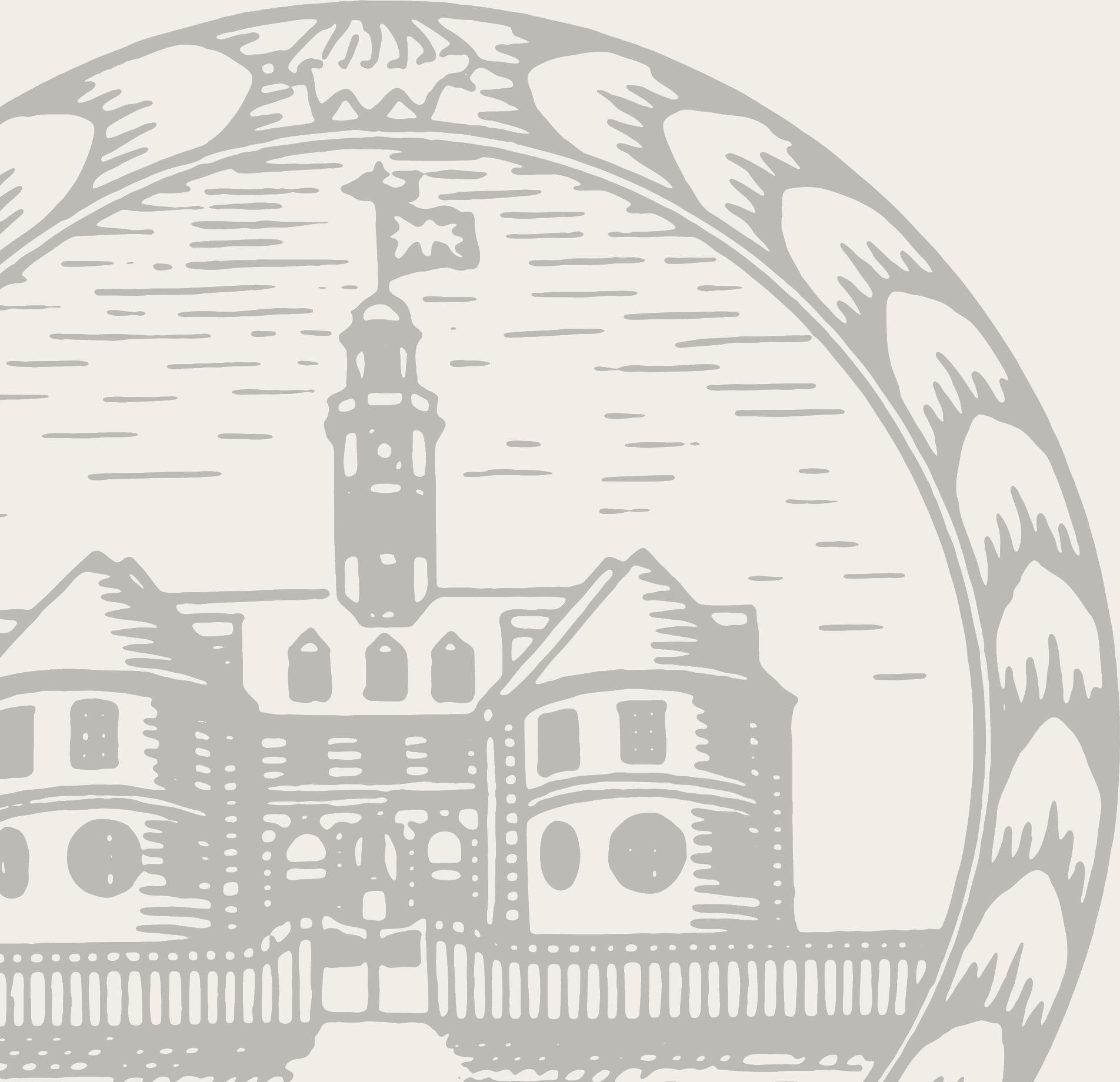
DONOR SOCIETIES NEWSLETTER
THE
